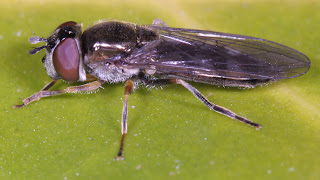Things are slowly starting up anywhere the sun gets to and the wind doesn't. Under the awning to the national Pool the Anthophora plumipes males are patrolling but hopefully there are no females about yet as the currant bushes are not yet in flower on the allotments nor is whatever else they use, just a few dandelions.
There was also one Lasioglossum morio female on dandelion:
The females occur alone at this time of the year nesting in bare ground and the males emerge later. They are thought to be primitively eusocial i.e. with workers the same as the queens. The head and thorax is more metallic bronzy green than this flash photo shows, the males are altogether more metallic green. Beware there are other species of metallic green Lasioglossum, I have recorded smeanthellum from gower. I have also recorded the small Andrena minutula from this site so the wings need checking carefully although it is not metallic.
In the university I found my first Platycheirus albinanus of the year, a female. This very common hoverfly has pairs of grey spots on the abdomen in the female but again beware as there are other species less common.
Last week I was at Oxwich one day and noticed the Dwarf Willow was not yet in flower in the dune slacks. When it is there will be many Colletes cunicularius feeding on the flowers and nesting on the sandy dune slopes. As you can see they look a bit like small bumble or honey bees:
but if you check the wing you will see a bend where marked with a V which goes towards the tip of the wing, a characteristic of Colletes bees.
There was also one Lasioglossum morio female on dandelion:
In the university I found my first Platycheirus albinanus of the year, a female. This very common hoverfly has pairs of grey spots on the abdomen in the female but again beware as there are other species less common.
Last week I was at Oxwich one day and noticed the Dwarf Willow was not yet in flower in the dune slacks. When it is there will be many Colletes cunicularius feeding on the flowers and nesting on the sandy dune slopes. As you can see they look a bit like small bumble or honey bees:
but if you check the wing you will see a bend where marked with a V which goes towards the tip of the wing, a characteristic of Colletes bees.
This bee is nationally quite scarce, I (and others) have found it on most of the gower dune systems but I have put it up becuase it is supposed to be spreading north and away from the coasts so might be worth keeping an eye out for inland.
If the warm weather promised for next week doesn't bring too much rain we might actually be able to get this spring under way, good luck.





No comments:
Post a Comment